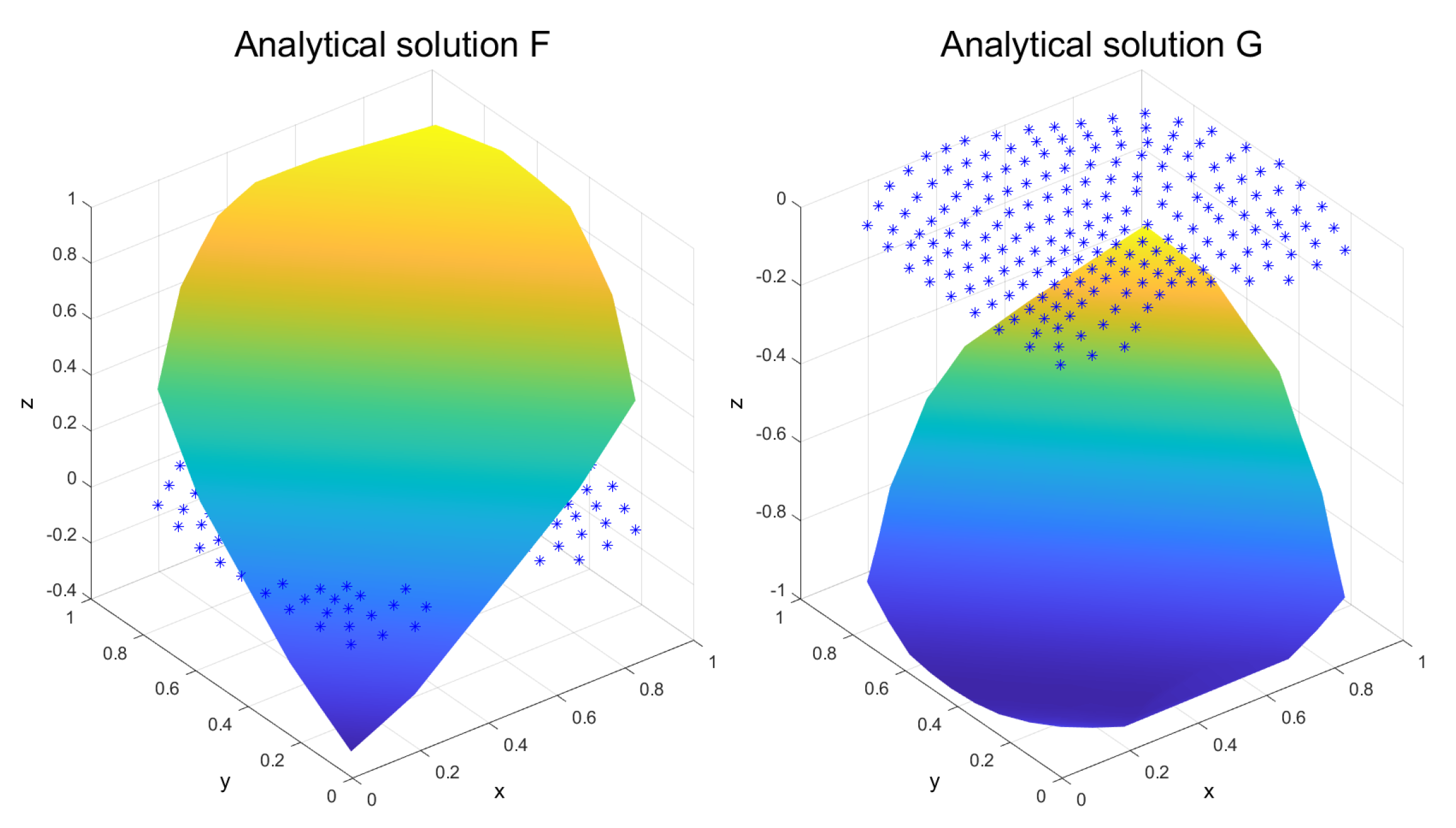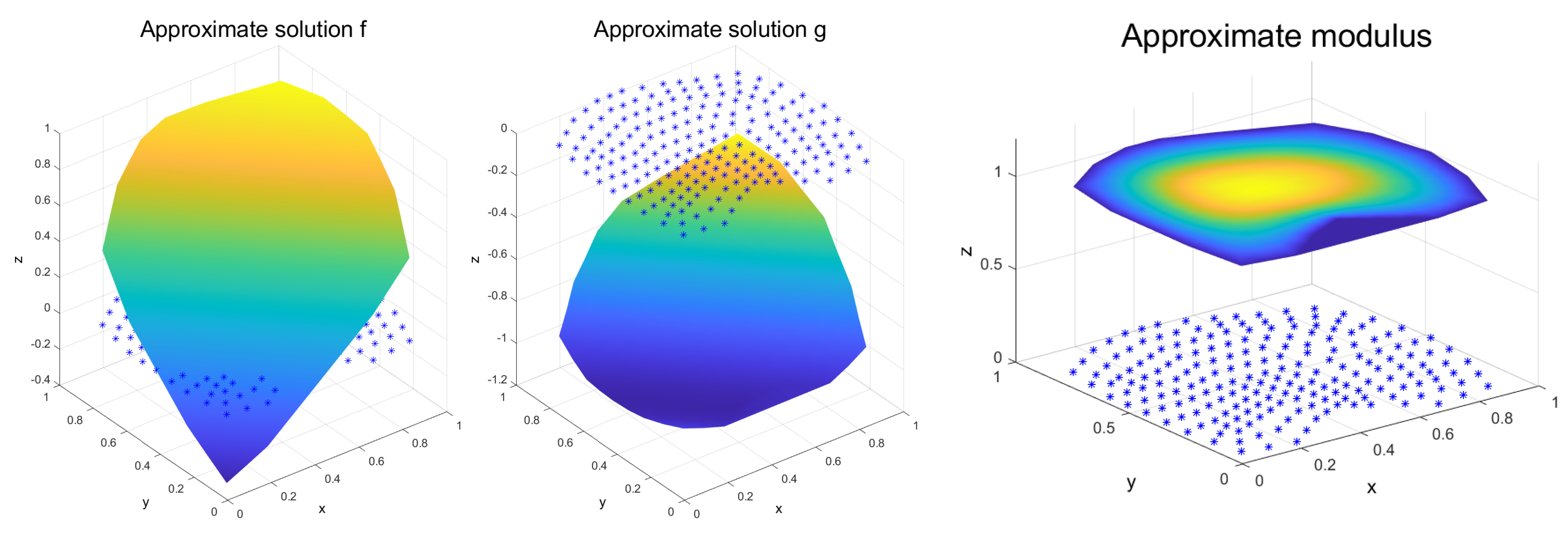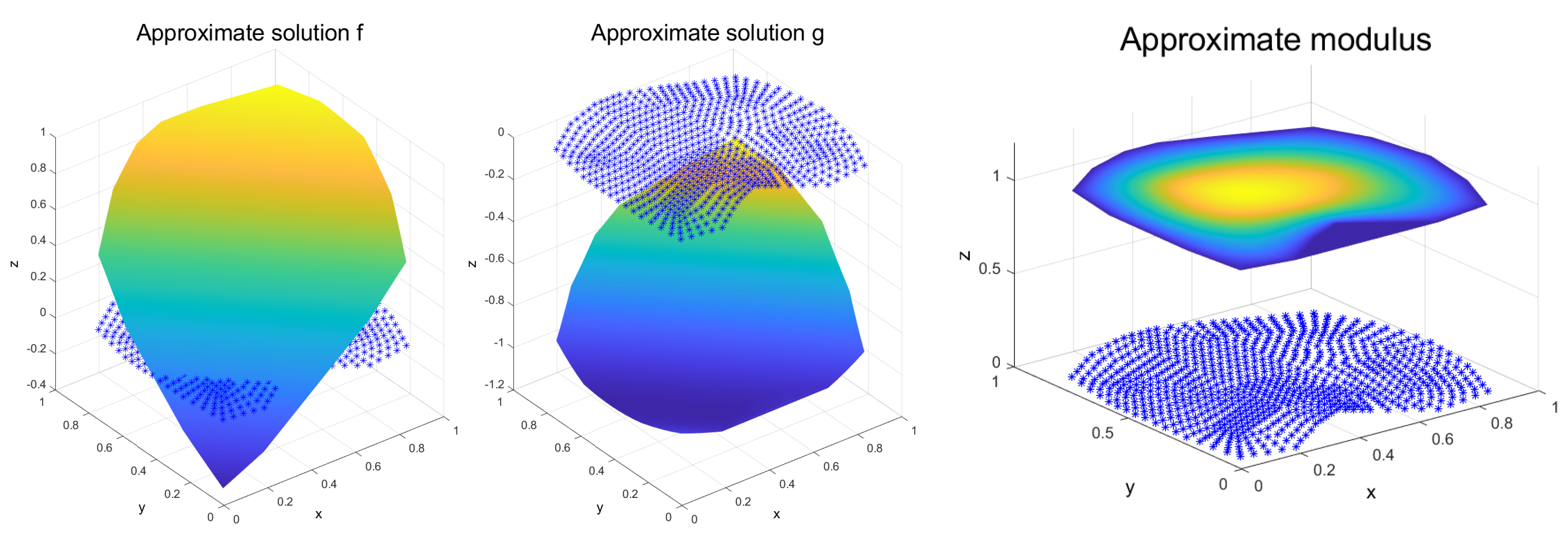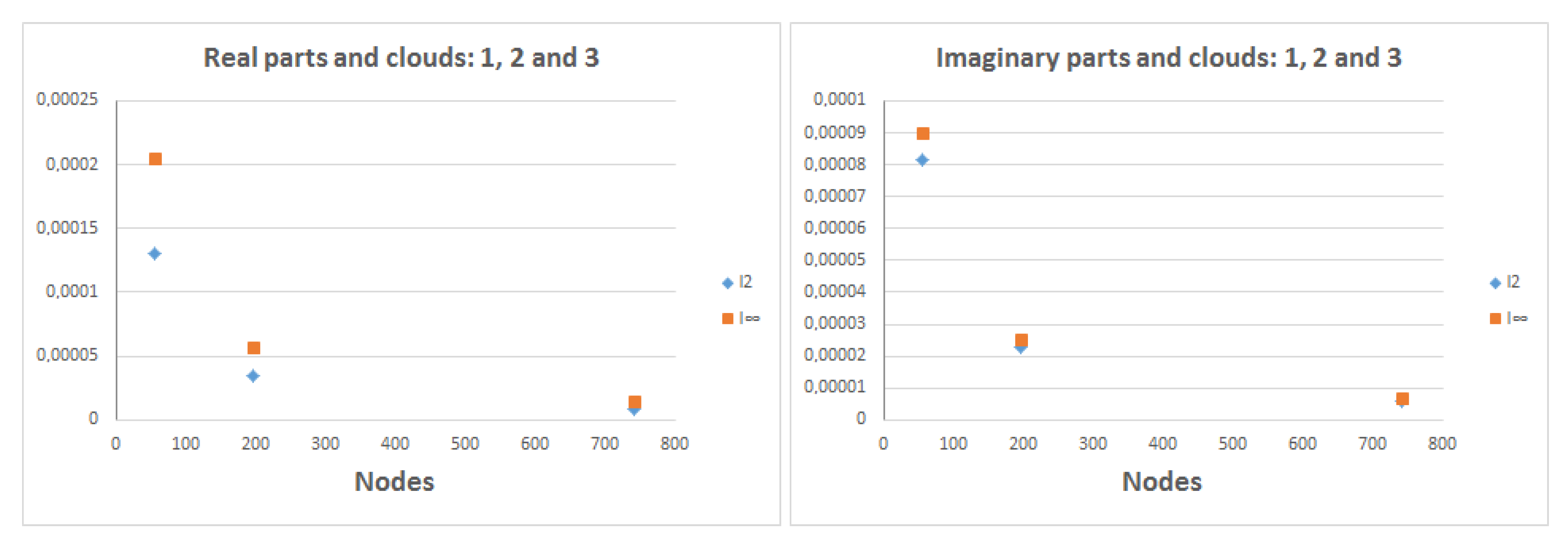Complex Ginzburg–Landau Equation with Generalized Finite Differences
Abstract
1. Introduction
2. Explicit Formulae
3. GFDM Schemes
- i.
- ii.
- ,
4. Numerical Results
4.1. Example 1
4.2. Example 2
4.3. Example 3
5. Conclusions
Author Contributions
Funding
Conflicts of Interest
References
- Shokri, A.; Dehghan, M. A Meshless Method Using Radial Basis Functions for the Numerical Solution of Two-Dimensional Complex Ginzburg-Landau Equation. CMES Comput. Model. Eng. Sci. 2012, 84, 333–358. [Google Scholar]
- Wang, B. Existence of Time Periodic Solutions for the Ginzburg-Landau Equations of Superconductivity. J. Math. Anal. Appl. 1999, 232, 394–412. [Google Scholar] [CrossRef]
- Du, Q.; Gunburger, M.D.; Peterson, J.S. Modeling and Analysis of a Periodic Ginzburg–Landau Model for Type-II Superconductors. SIAM J. Appl. Math. 1992, 53, 689–717. [Google Scholar] [CrossRef]
- Wang, T.; Guo, B. Analysis of some finite difference schemes for two?dimensional Ginzburg-Landau equation. Numer. Methods Partial Differ. Equ. 2011, 25, 1340–1363. [Google Scholar] [CrossRef]
- Geiser, J.; Nasari, A. Comparison of Splitting Methods for Deterministic/Stochastic Gross-Pitaevskii Equation. Math. Comput. Appl. 2019, 24, 76. [Google Scholar] [CrossRef]
- Geiser, J. Iterative Splitting Method as Almost Asymptotic Symplectic Integrator for Stochastic Nonlinear Schrödinger Equation. AIP Conf. Proc. 2017, 1863, 560005. [Google Scholar] [CrossRef]
- Geiser, J.; Nasari, A. Simulation of multiscale Schrödinger equation with extrapolated splitting approaches. AIP Conf. Proc. 2019, 2116, 450006. [Google Scholar] [CrossRef]
- Trofimov, V.A.; Peskov, N.V. Comparison of finite difference schemes for the Gross-Pitaevskii equation. Math. Model. Anal. 2009, 14, 109–126. [Google Scholar] [CrossRef]
- Liszka, T.; Orkisz, J. The finite difference method at arbitrary irregular grids and its application in applied mechanics. Comput. Struct. 1980, 11, 83–95. [Google Scholar] [CrossRef]
- Benito, J.J.; Ureña, F.; Gavete, L. Influence of several factors in the generalized finite difference method. Appl. Math. Model. 2001, 25, 1039–1053. [Google Scholar] [CrossRef]
- Gavete, L.; Benito, J.J.; Ureña, F. Generalized finite differences for solving 3D elliptic and parabolic equations. Appl. Math. Model. 2016, 40, 955–965. [Google Scholar] [CrossRef]
- Ureña, F.; Benito, J.J.; Gavete, L. Application of the generalized finite difference method to solve the advection-diffusion equation. J. Comput. Appl. Math. 2011, 235, 1849–1855. [Google Scholar]
- Wang, Y.; Gu, Y.; Liu, J. A domain–decomposition generalized finite difference method for stress analysis in three-dimensional composite materials. Appl. Math. Lett. 2020, 104, 106226. [Google Scholar] [CrossRef]
- Ureña, F.; Gavete, L.; Benito, J.J.; García, A.; Vargas, A.M. Solving the telegraph equatio. Eng. Anal. Bound. Elem. 2020, 112, 13–24. [Google Scholar] [CrossRef]
- Benito, J.J.; García, A.; Gavete, M.L.; Gavete, L.; Negreanu, M.; Ureña, F.; Vargas, A.M. Numerical Simulation of a Mathematical Model for Cancer Cell Invasion. Biomed. J. Sci. Tech. Res. 2019, 23, 17355–17359. [Google Scholar]
- Benito, J.J.; García, A.; Gavete, L.; Negreanu, M.; Ureña, F.; Vargas, A.M. On the numerical solution to a parabolic-elliptic system with chemotactic and periodic terms using Generalized Finite Differences. Eng. Anal. Bound. Elem. 2020, 113, 181–190. [Google Scholar] [CrossRef]
- Lancaster, P.; Salkauskas, K. Curve and Surface Fitting; Academic Press Inc.: London, UK, 1986. [Google Scholar]
- Gavete, L.; Ureña, F.; Benito, J.J.; Garcia, A.; Ureña, M.; Salete, E. Solving second order non-linear elliptic partial differential equations using generalized finite difference method. J. Comput. Appl. Math. 2017, 318, 378–387. [Google Scholar] [CrossRef]
- Fan, C.M.; Huang, Y.K.; Li, P.W.; Chiu, C.L. Application of the generalized finite-difference method to inverse biharmonic boundary value problems. Numer. Heat Transf. Part B Fundam. 2014, 65, 129–154. [Google Scholar] [CrossRef]
- Ureña, F.; Gavete, L.; Garcia, A.; Benito, J.J.; Vargas, A.M. Solving second order non-linear parabolic PDEs using generalized finite difference method (GFDM). J. Comput. Appl. Math. 2019, 354, 221–241. [Google Scholar] [CrossRef]
- Isaacson, E.; Keller, H.B. Analysis of Numerical Methods; John Wiley & Sons Inc.: New York, NY, USA, 1966. [Google Scholar]
- Kong, L.; Kuang, L. Efficient numerical schemes for two-dimensional Ginzburg-Landau equation in superconductivity. Discret. Contin. Dyn. Syst. Ser. B 2019, 24, 6325–6327. [Google Scholar] [CrossRef]







| t (s) | 0.25 | 0.5 | 2 |
| cloud 1 (55 nodes) | |||
| cloud 2 (197 nodes) | |||
| cloud 3 (743 nodes) | |||
| t (s) | 0.25 | 0.5 | 2 |
| cloud 1 (55 nodes) | |||
| cloud 2 (197 nodes) | |||
| cloud 3 (743 nodes) |
| t (s) | 0.25 | 0.5 | 2 |
| cloud 1 (55 nodes) | |||
| cloud 2 (197 nodes) | |||
| cloud 3 (743 nodes) | |||
| t (s) | 0.25 | 0.5 | 2 |
| cloud 1 (55 nodes) | |||
| cloud 2 (197 nodes) | |||
| cloud 3 (743 nodes) |
| t (s) | 0.25 | 0.5 | 2 |
| 3.6219 | 3.5817 | 3.7938 | |
| 3.7726 | 3.7859 | 3.8585 | |
| t (s) | 0.25 | 0.5 | 2 |
| 3.5768 | 3.6024 | 3.5824 | |
| 3.8008 | 3.7565 | 3.7705 |
| t (s) | 0.25 | 0.5 | 2 |
| 3.5819 | 3.5812 | 3.5821 | |
| 3.7727 | 3.7661 | 3.7724 | |
| t (s) | 0.25 | 0.5 | 2 |
| 3.5772 | 3.5631 | 3.5795 | |
| 3.7771 | 3.7446 | 3.7627 |
Publisher’s Note: MDPI stays neutral with regard to jurisdictional claims in published maps and institutional affiliations. |
© 2020 by the authors. Licensee MDPI, Basel, Switzerland. This article is an open access article distributed under the terms and conditions of the Creative Commons Attribution (CC BY) license (http://creativecommons.org/licenses/by/4.0/).
Share and Cite
Salete, E.; Vargas, A.M.; García, Á.; Negreanu, M.; Benito, J.J.; Ureña, F. Complex Ginzburg–Landau Equation with Generalized Finite Differences. Mathematics 2020, 8, 2248. https://doi.org/10.3390/math8122248
Salete E, Vargas AM, García Á, Negreanu M, Benito JJ, Ureña F. Complex Ginzburg–Landau Equation with Generalized Finite Differences. Mathematics. 2020; 8(12):2248. https://doi.org/10.3390/math8122248
Chicago/Turabian StyleSalete, Eduardo, Antonio M. Vargas, Ángel García, Mihaela Negreanu, Juan J. Benito, and Francisco Ureña. 2020. "Complex Ginzburg–Landau Equation with Generalized Finite Differences" Mathematics 8, no. 12: 2248. https://doi.org/10.3390/math8122248
APA StyleSalete, E., Vargas, A. M., García, Á., Negreanu, M., Benito, J. J., & Ureña, F. (2020). Complex Ginzburg–Landau Equation with Generalized Finite Differences. Mathematics, 8(12), 2248. https://doi.org/10.3390/math8122248





